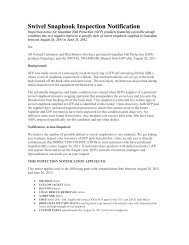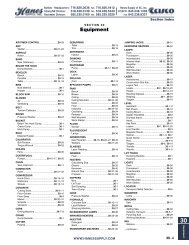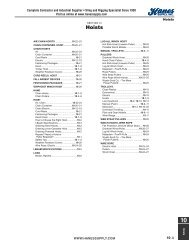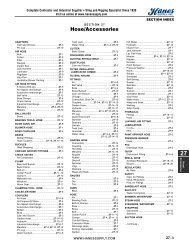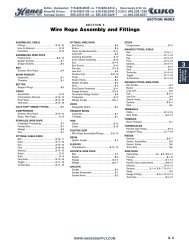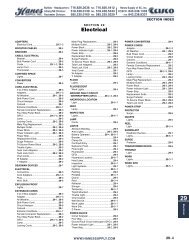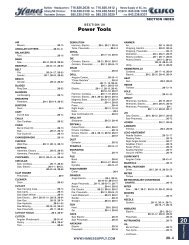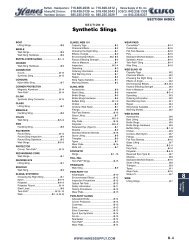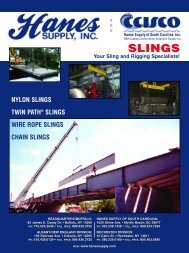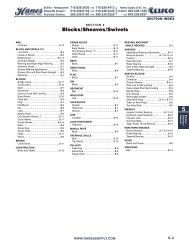YOUR SLING AND RIGGING SPECIALIST<strong>tw<strong>in</strong></strong>-Path ® <strong>sl<strong>in</strong>gs</strong>7.0 - Mechanical Considerations7.21 The <strong>sl<strong>in</strong>gs</strong> should conta<strong>in</strong> or support the load from the sides above the center of gravity so that the loadwill not tilt when the load is lifted.7.22 Sl<strong>in</strong>gs shall be of the proper length so that the angle of the sl<strong>in</strong>g to the load does not reduce the ratedcapacity of the sl<strong>in</strong>g for a given angle.7.23 Use only if tra<strong>in</strong>ed. Read and understand tag. Only legibly marked or labeled <strong>sl<strong>in</strong>gs</strong> must be used.If the tag is not legible, or miss<strong>in</strong>g, the sl<strong>in</strong>g must not be used.7.24 Keep labels or tags away from the load, the hook and the angle of choke.7.25 Synthetic <strong>sl<strong>in</strong>gs</strong> should be <strong>in</strong>spected each time before each lift.8.0 - Environmental Considerations8.1 When not <strong>in</strong> use, synthetic <strong>sl<strong>in</strong>gs</strong> should be stored <strong>in</strong> a clean dry place. Heat sources and non-ventilatedplaces should be avoided.8.2 Chemically active environments can affect the strength of synthetic lift<strong>in</strong>g <strong>sl<strong>in</strong>gs</strong>. Different chemicals willreact with different exposure to Covermax ® bulked nylon, polyester, aramids, and Olef<strong>in</strong>s.Aramids are resistant to most ketones, alcohols, dry clean<strong>in</strong>g solvents and many other organic solvents. Its acidresistance is superior to that of nylon but is not as good as that of polyester. Aramids show good resistance toalkalis at room temperature, but is degraded by strong alkalis at higher temperatures.Aramids are compatible with fluor<strong>in</strong>e-conta<strong>in</strong><strong>in</strong>g elastomers, res<strong>in</strong>s, and refrigerants at high temperatures,and is resistant to fluor<strong>in</strong>e compounds <strong>in</strong> concentrations usually encountered <strong>in</strong> stack gases from metallurgicaland rock-process<strong>in</strong>g operations.The resistance of aramids to oxides of sulphur at temperatures above the acid dew po<strong>in</strong>t is superior to that ofpolyester. Below the dew po<strong>in</strong>t, concentrated sulphuric acid may condense on the fiber and cause a progressiveloss <strong>in</strong> strength.In moderate to strong acid or alkali environments, evaluation of aramids should be made to ensure that the yarnwill perform acceptably before use.Polyester and nylon are not significantly affected by most compounds of the follow<strong>in</strong>g classes: Alcohols, DryClean<strong>in</strong>g Solvents, Halogenated Hydrocarbons, Ketones, Soaps and Synthetic Detergents, and Water(<strong>Inc</strong>lud<strong>in</strong>g Sea Water).Polyester also shows good to excellent resistance to:• Aqueous solutions of most weak acids at the boil, and to most strong acids at room temperature,but is dis<strong>in</strong>tegrated by concentrated (95%) sulphuric acid at room temperature.• Aqueous solutions of strong alkalis at room temperature, but is degraded at the boil.• Oxidiz<strong>in</strong>g agents, and is not degraded by bleach<strong>in</strong>g treatments ord<strong>in</strong>arily used for textiles.Nylon is not significantly affected by most aldehydes, alkalis, ethers, or hydrocarbons, but is deteriorated bydilute acids (e.g., hydrochloric acid and sulphuric acid <strong>in</strong> 10% concentrations at room temperature cause anoticeable loss <strong>in</strong> break<strong>in</strong>g strength <strong>in</strong> 10 hours).HEADQUARTERS: 55 James E. Casey Drive • Buffalo, NY 14206 PHONE: 716.826.2636 FAX: 716.826.4412 www.hanessupply.com20
<strong>tw<strong>in</strong></strong>-Path ® <strong>sl<strong>in</strong>gs</strong>YOUR SLING AND RIGGING SPECIALISTSolvents for nylon <strong>in</strong>cludes: Concentrated formic acid, Phenolic compounds at room temperature, Calciumchloride <strong>in</strong> methanol at room temperature.Hot solutions of calcium chloride <strong>in</strong>: Glacial Acetic Acid, Ethylene Chlorohydr<strong>in</strong>, Ethylene Glycol.Hot solutions of z<strong>in</strong>c chloride <strong>in</strong> methanol Benzyl alcohol at the boil.Aramids are resistant to most weak acids and alkalis, ketones, alcohols, hydrocarbons, oils and dry clean<strong>in</strong>gsolvents. Strong acids and bases and sodium hypo-chlorite bleach attack aramids, particularly at high temperaturesof high concentrations.K-Spec ® core yarn strength retention is based on test results of components at 65°C/150°F (or less) for 6months. K-Spec ® has a 100% strength retention when exposed to: Age,10% detergent solution, rot and mildew,sunlight and Toluene; 99% strength retention when exposed to: acetic acid, gasol<strong>in</strong>e, hydrochloric acid 1m, hydraulicfluid, kerosene, and sea water; 98% retention when exposed to: 25% ammonium hydroxide, 10% hypophosphitesolution, and 40% phosphoric acid; 97% retention when exposed to 5m sodium hydroxide; 95%retention when exposed to Portland cement and sulfuric acid; and 88% retention when exposed to Clorox , ® andnitric acid.9.0 - Fiber Characteristics(Us<strong>in</strong>g Nylon as a basis of 1.0)Generic Fiber Polypro- HDPEType Nylon Polyester Pylene Olef<strong>in</strong> Aramid K-Spec ®Bulk Strength 1 1.0 .9- 1.1 .55 2.8 2.7 2.75Weight 1.0 1.21 .80 .85 1.26 1.01Work<strong>in</strong>g 2 Elastic 1.0 .60 .80 .10 .10 .10ElongationCo-efficient 3 of .10 -.12 .12-.15 .15 - .22 .08 .10 - .12 .10FrictionChars at Chars atMelt<strong>in</strong>g Po<strong>in</strong>t 460°F 480°F 330°F 297°F 800°F 297°FCritical 4 Temperature 180°F 180°F 180°F 150°F 300°F 180°FSpecific Gravity 1.14 1.38 .91 .97 1.44 1.2Cold-Flow (Creep) 5 Negligible Negligible Negligible Negligible Negligible Negligibleto High to High1Bulk Strength is def<strong>in</strong>ed as strength per circumference squared.2Work<strong>in</strong>g is def<strong>in</strong>ed as rope actually <strong>in</strong> use under a cycl<strong>in</strong>g load.3Co-efficient of friction is based on reluctance to slip or slide.4Critical temperature is def<strong>in</strong>ed as the po<strong>in</strong>t at which degradation is caused by temperature alone.5Cold-Flow (Creep) is def<strong>in</strong>ed as fiber deformation (elongation) due to molecular slippage under a constant steady static load<strong>in</strong>gsituation. Fibers that have this <strong>in</strong>herent characteristic will display extremely low or negligible creep if m<strong>in</strong>or fluctuations occur<strong>in</strong> the rate and/or frequency of load levels. In rope form, this would apply to polypropylene, polyethylene, and HDPE Olef<strong>in</strong> fibers.HEADQUARTERS: 55 James E. Casey Drive • Buffalo, NY 14206 PHONE: 716.826.2636 FAX: 716.826.4412 www.hanessupply.com21



